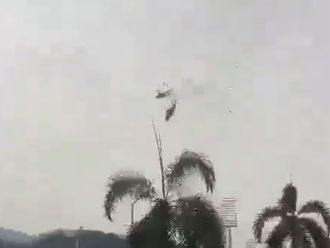Tamil Tiger Rebel Base, Sri Lanka: Past the minefield-line paved road, down a sandy track hemmed in by coconut palms and thatch huts, the gate appears, a metal boom bookended by log-and-sandbag bunkers.
It's not visible until you're on top of it, and the lone sentry's tiger-striped camouflage is the only sign this is a Tamil Tiger rebel base.
"The people who need to know our soldiers, the villagers who aid us they know we are here," said Muttiah Jayanthy, 33, one of the base's top officers. "If there is war, the government will feel our presence."
A surge in violence has left Sri Lanka dangerously close to resuming a war best known for its suicide bombings a vicious conflict that for 18 years pitted rebels from the Hindu Tamil minority against the government dominated by the Buddhist Sinhalese majority.
The Tigers agreed to let The Associated Press make a rare visit to a front-line rebel base on the condition that its location not be revealed.
The trip was tightly controlled, and only a dozen of the 2,000 fighters said to operate out the base were made available to speak. But it provided a rare snapshot of how the Tigers think and what they are preparing for.
In interview after interview in the past week, the fighters talked of their readiness to die for a Tamil homeland. One said she had volunteered to become a suicide bomber, known as a Black Tiger; another admitted she was once a child soldier.
Much of what they said was stock rhetoric, with repeated references to "historic responsibility" and "occupation forces". How much they had been ordered to say, how much came from indoctrination and how much was heartfelt was hard to judge.
But none showed doubts.
"Only by war can we get our homeland back, our identity, our dignity," Jayanthy said.
Using a Tamil homeland as an inspiration along with a feared intelligence network the Tigers have shaped a cult-like force whose fighters carry cyanide to swallow if they are captured.
Only the top commanders are given ranks; soldiers must wait until death.
"It is a final judgment on how we lived and fought," Jayanthy said.
The rebels' secretive chief, Velupillai Prabhakaran, is reverently referred to as "The Leader." He's rarely seen by outsiders, although pictures of the chubby commander are omnipresent in Tiger territory.
The Tigers will not say how large their force is, but they are estimated to have 5,000 to 7,000 fighters, and as many as half are believed to be children pressed into service.
Backed by artillery and small naval gunboats, the rebels have waged guerrilla campaigns and have bested Sri Lanka's 66,000-strong army in conventional battles.
The Tigers have turned a half-century of alleged discrimination against Sri Lanka's 3.2 million Tamils into a well-developed narrative of oppression.
Nearly all Tamils can rattle off the "offences" against Tamil pride the adoption of Sinhala as the sole national language in 1956; decades of anti-Tamil riots; and the 1981 burning of the Jaffna library that destroyed ancient Tamil manuscripts and modern archives.
The Tigers took up arms in 1983. The resulting war on this tropical island of 19 million people nearly three-quarters of them Sinhalese left more than 65,000 people dead before the 2002 ceasefire.












